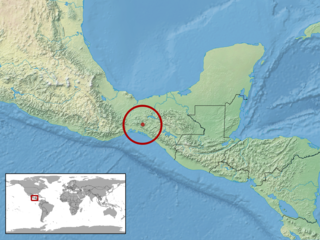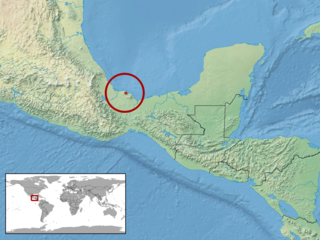
Abronia is a genus of lizards in the family Anguidae. The genus is native to northern Central America, occurring mainly in Guatemala and Mexico. However, there are species that occur as far south as El Salvador and Honduras, for example, A. montercristoi. Abronia species are almost exclusively arboreal. These lizards possess intriguing physical traits such as keeled body scales, patterns on each individual scale, and some, for example, A. lythrochila, even have spikes on the back of the head. Traits vary from species to species.

The Mexican alligator lizard, also known as the green arboreal alligator lizard, is an endangered species of lizard endemic to the Sierra Madre de Oaxaca highlands of Mexico. It can be found in the states of Puebla, Veracruz, and Oaxaca. It was originally described under the genus Gerrhonotus as Gerrhonotus gramineus by Edward D. Cope in 1864.

Abronia bogerti, known by the common name Bogert's arboreal alligator lizard, is a species of lizard in the family Anguidae. The species is endemic to Mexico.

Abronia chiszari, Chiszar's arboreal alligator lizard, is an endangered species of arboreal alligator lizard in the family Anguidae. The species is native to east-central Mexico.

Abronia deppii, Deppe's arboreal alligator lizard, is an endangered species of arboreal alligator lizard in the family Anguidae. The species was described in 1828 by Arend Friedrich August Wiegmann, and it is endemic to Mexico.

Abronia leurolepis is an arboreal alligator lizard that is endemic to Mexico. Its common name is smoothback arboreal alligator lizard.

Abronia martindelcampoi, Martín del Campo's arboreal alligator lizard, is an endangered species of arboreal alligator lizard described in 2003 by Flores-Villela and Sánchez-Herrera.

Abronia matudai, Matuda's arboreal alligator lizard, is a species of endangered arboreal alligator lizard in the family Anguidae. The species, which was originally described in 1946 by Norman Hartweg and Joseph Tihen, is endemic to Central America.

Abronia mitchelli, Mitchell's arboreal alligator lizard, is a species of arboreal alligator lizard in the family Anguidae. The species, which was originally described in 1982 by Jonathan A. Campbell, is endemic to southwestern Mexico.

Abronia ochoterenai, Ochoterena's arboreal alligator lizard or Northern Chiapas arboreal alligator lizard, is a species of arboreal alligator lizard in the family Anguidae. The species, which is native to extreme southern Mexico, was described in 1939 by Rafael Martín del Campo.

Abronia ornelasi, Ornelas's arboreal alligator lizard or Cerro Baul alligator lizard, is a species of arboreal alligator lizard in the family Anguidae. The species, which was originally described in 1984 by Jonathan A. Campbell, is endemic to southern Mexico.

Abronia ramirezi, Ramirez's alligator lizard, is species of arboreal alligator lizard in the family Anguidae. The species, which was described in 1994 by Campbell, is endemic to Mexico.

Abronia reidi, Reid's arboreal alligator lizard, is a species of arboreal alligator lizard in the family Anguidae. The species is native to Mexico. It was described as a species new to science in 1961 by John E. Werler and Frederick A. Shannon.

Abronia smithi is a species of lizard in the family Anguidae. Known by the common name Smith's arboreal alligator lizard, the species is endemic to the state of Chiapas in Mexico.
Abronia campbelli, commonly known as Campbell's alligator lizard, is species of critically endangered arboreal alligator lizard in the family Anguidae. Abronia campbelli is endemic to eastern Guatemala.
The Anzuetoi arboreal alligator lizard, also known commonly as Anzueto's arboreal alligator lizard, is a species of lizard in the family Anguidae. The species is endemic to Volcán de Agua in Guatemala.
Cope's arboreal alligator lizard is a species of lizard found in two isolated locations in Guatemala, one in the Alta Verapaz Department and one in the Jalapa Department. These lizard are found only in high altitudes of 2,000 to 2,600 feet above sea level, on the west and south sides of the mountain ranges. This lizard is one of 28 species of alligator lizards, most being arboreal, meaning they live in trees. These omnivores are considered endangered because of their small population size and they face extinction due to habitat degradation and from pressures of the pet trade.
Frost's arboreal alligator lizard is a species of lizard endemic to Central America.
Abronia vasconcelosii, sometimes known as Bocourt's arboreal alligator lizard, is a species of lizard in the family Anguidae. It is endemic to Guatemala Plateau. It occurs in lower montane moist forest at elevations of 2,000–2,200 m (6,600–7,200 ft) above sea level.
Abronia meledona is an endangered species of arboreal alligator lizard described in 1999 by Campbell and Brodie from Guatemala.















